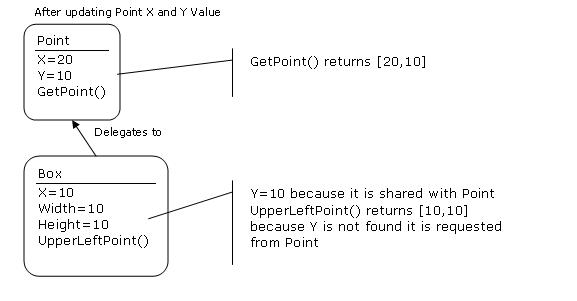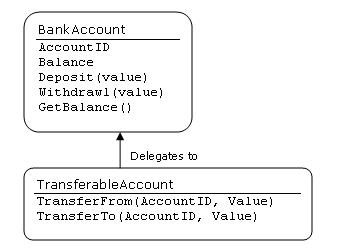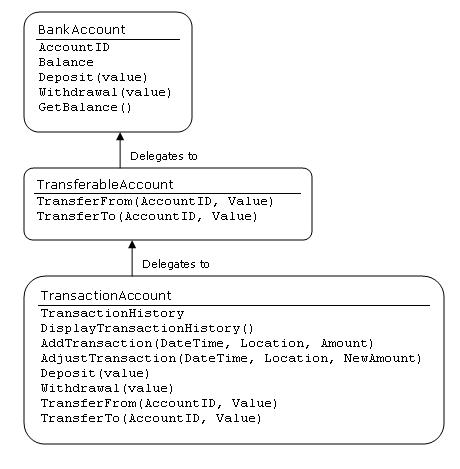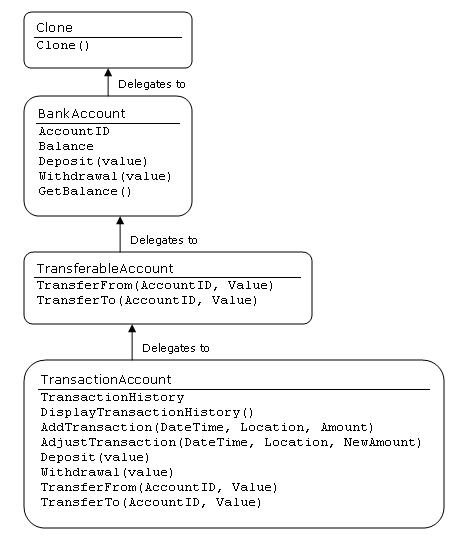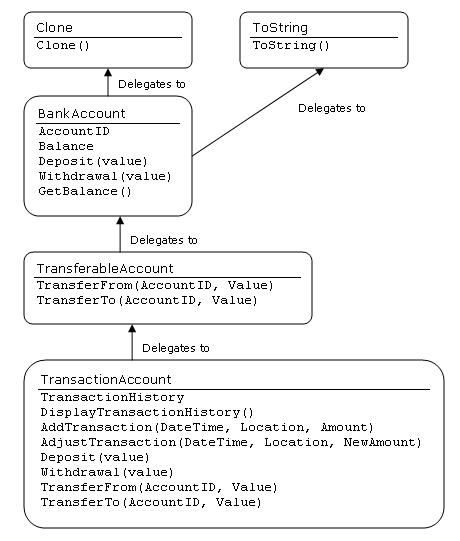CSC/ECE 517 Fall 2010/ch2 2c ck
Introduction
Dictionary Definition of Prototype: 'An original, full-scale, and usually working model of a new product or new version of an existing product'.[1]
"... the prototype approach in some ways corresponds more closely to the way people seem to acquire knowledge from concrete situations"[2]
Since the early period of implementation of Object Oriented Design (OOD), there have been two schools of thought concerning the best method of implementing OOD. The class approach, which is the static method of implementation. And the Prototype approach, which is the dynamic method of implementation.
The class based implementation of OOD is very rigid and favors a design first approach. The prototype based implementation of OOD favors a design as we go or iterative approach.
This article assumes that the reader is familiar with class based object oriented design and will focus mostly on the specifics of prototype based object oriented design. In doing so, we will also contrast the differences between the two and try to determine what is in the future.
Brief History
Even though the prototype implementation of OOD has been around for a long time, it took a very long time to reach the mainstream development community. The purest form was in a language called Self[3]. Self, was created in 1986 as a project at Sun Labs. It was one of the first languages to support prototyping and it was built entirely from the ground up using prototypes. In 1995 version 4 was released and Sun culminated it as a project. Even though it is no longer an official project at Sun Labs, Sun Labs stills ports version 4 to keep it runing on several OS's. It is now at version 4.4.
Prototype OOD reached the mainstream development community when the internet became popular and it was adopted by ECMAScript(JavaScript) as their OOD environment in 1997.[4] and also in Adobe Flash Action Script. There was a lot of speculation that version 4.0 of ECMAScript would have traditional classes instead of or in addition to prototyping, however verion 4.0 was never realeased. When version 5.0 of ECMAScript.[5] was released in December 2009, prototyping still existed as the only OOD that was to be supported.
Even some class based languages, such as C# [6] in particular and several others in general, implemented a variation of prototyping called extensions. 'Extension methods enable you to "add" methods to existing types without creating a new derived type, recompiling, or otherwise modifying the original type.' .[6]. While this does not have all of the features that a prototyping language does, it shows the influence that prototype OOD has had on many of the main stream languages in use today.
Delegation
The mechanism for implementation of prototyping is called Delegation.[2]
'Operationally, delegation is the redirection of field access and method invocation from an object or prototype to another, in such a way that an object can be seen as an extension of another.' [7]
Delegation is a process whereby an existing object dynamically searches for properties and methods first within itself, then if an match is not found, it delegates that search to its parent object. The parent then repeats the exact same delegation process until a match is found. Once a match is found the result is returned to the requester.
Simple Example
This example demonstrates two objects that I always want aligned on the same y axis, however I want them to be independent on the x axis.
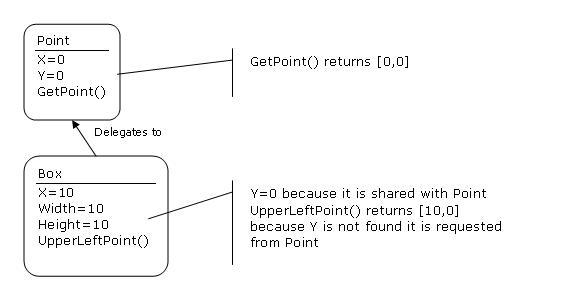
Box remains as is but Point is changed
NOTE: In the above example Box.GetPoint() would also return [10,10]. When GetPoint() searches for X it starts at the original requestors level and uses delegation just like the method search for Box.GetPoint().
While delegation is simple in its design, we will see that it is also elegant. In that it opens the door for several different techniques which allow software developers to morph an existing object, into a much larger and more robust object. While still retaining the original objects simplicity.
Competing Approaches
Class Approach
New objects are made from predefined classes. A class definition must exist to create an instance of a class. When a class is changed, existing objects must be reconstructed and we also need to ensure that nothing else in the application requires the prior classes constructed behavior.
Prototype Approach
New objects are constructed by copying an existing object. After copying we are safe to change the class behavior knowing that we are independent of all other objects. Prototyping is dynamic allowing us to create a real world object as a single instance and then refactor it at run time.
- We can add to it.
- We can remove parts from it.
- We can break parts out and move to a different location in the same delegation tree. Thereby extending the original behavior to more objects in the same object hierarchy.
Contrasting Development Styles[7]
| Class Development Style | Prototype Development Style |
|---|---|
| Must think about objects abstractly and develop a model to simulate behavior | Most people can think clearly about objects that already exist |
| Many people lack the ability to perform well when working with abstract thoughts | Most people have the ability to perform well when working with real world objects |
| Good communication is limited to those that can think abstractly | Good communication is open to normal methods of everyday interaction |
| Real world examples need to be broken down to a model and then reconstructed before they can be worked with | Real world examples can be worked with in real time, there is no need to model behavior |
Analysis2
Advantages of Prototype
- Reduces development time.
- Reduces development costs.
- Developers receive quick results and can move on to the next task.
Disadvantages of Prototype
- Can lead to insufficient analysis.
- The performance may be degraded by prototype overhead.
- Can cause systems to be left unfinished and/or implemented before they are ready.
- Sometimes leads to incomplete documentation.
Prototype Inheritance
As we will see, some dynamic languages use prototyping to support dynamic inheritance and multi-inheritance.
All object inheritance is initially copied from an existing object, then when additional functionality is desired, inheritance may be added at runtime via delegation.
The biggest design benefit of prototype inheritance is that inheritance functionality may be added anywhere within the existing objects class tree. It may be added to (or removed from) the end, the beginning, or anywhere in the middle. It is very flexible and powerful.
Real World Example
A bank account
Class Approach
Focus of thought is constantly changing:
- Start with use cases
- Create a class diagram
- Write Code
- Experiment
- Modify class diagram
- Refactor
- Write Code
- Rewrite code that depended on the functionality removed from prior class diagram.
- Goto step 4
Prototype Approach
Lets just build a bank account object and code it right now.
Now I can show it to other people and get their inputs.
I show my account to Mary and she interacts with it. Mary says that she has several accounts and often transfers money between them. I add the following to my account object. TransferFrom(account, value) TransferTo(account, value)
I show the new account object to Bill who is a teller. Bill replies that he needs to see all of the customers transactions because sometimes he is asked a question about a particular transaction. Bill adds that if management approves the dispute, he needs to be able to modify a prior transaction. I add the following to my account object: TransactionHistory [[date location amount],[date location amount],[date location amount]] DisplayTransactionHistory() AddTransaction(DateTime, Location, Amount) AdjustTransaction(DateTime, Location, NewAmount) Now that I am tracking transactions, I want deposits, withdrawals and transfers to create transactions. Therefore, I also add the following: Deposit(value) Withdrawal(value) TransferFrom(account, value) TransferTo(account, value)
Now I have an awesome account object, but I only have one. <pre> I need a way to copy this object so that I can give accounts to all of my friends. I then add the following Clone() However, I want Clone() to be available to all existing objects. Instead of delegating from Clone to TransactionAccount, I am going to delegate from BankAccount to Clone.
I would also like a ToString() for all objects. But, I do not need a Clone.ToString(). I am going to delegate from BankAccount to ToString.
Clone and Change Technique
Now that I have a clone() method, I can clone an existing object then morph it into a different object.
Given the above example. If I want to create an ATM account.
ATMAccount = TransferableAccount.Clone() def ATMAccount.Pin end def ATMAccount.DailyLimit end def ATMAccount.LastTransaction end def ATMAccount.DailyTotal end
Clone Types
When copying a prototype object, there are different types of copying the existing object.
When using a prototype language, this is usually not a choice, it is implemented by the language.
Deep Copy
A deep copy, duplicates both the copied object and all objects that are delegated to.
In the above example a deep copy of TransferableAccount would make copies of TransferableAccount, BankAccount, Clone, ToString.
The benefit is that all parts may be modified without effecting the original object. The downside is that it consumes more resources.
Shallow Copy
A shallow copy, duplicates only the copied object and delegates to the same objects as the original.
The benefit is that it consumes less resources. The downside is that modification of a delegated object also effects the original object.
Lazy Copy or Copy on Write
A hybrid of a deep and shallow copy that gives the benefits of both.
As in a shallow copy, clone() duplicates only the copied object and delegates to the same objects as the original.
However when a delegated object is modified, a copy of the object to be modified is performed before the modification, and the delegate is adjusted to point to the copy. Then the copy is modified.
Conclusion
The debate over which is better, class based OOD or prototype based OOD, has been around since the beginning of OOD. Prototype OOD appears to be gaining some mainstream ground, but it is still a long way from taking over traditional class based OOD. It is this authors opinion that this debate is ongoing and will exist in one form or another into the future. I believe that in the past 15 years, neither has proven to be advantagous in all circumstances over the other. I also believe that the evolution of some hybrid language features that attempt to bridge the gap will continue to evolve. I beleive that the future will at times lean in the direction of one or in the direction of the other, bull will never quite cuminate on one or the other.
References
[1] Yahoo Online Dictionary - Prototype
[2] Using Prototypical Objects to Implement Shared Behavior in Object Oriented Systems By: Henry Lieberman
[3] Self - The power of Simplicity By: David Ungar and Randall B - 1986
[4] ECMA 262 standard version 1.0 July 1997
[5] ECMA 262 standard version 5.0 December 2009
[6] MSDN article on C# Extension Methods
[7] Object-based vs. Class-based Languages - Digital Equipment Corporation Systems Research Center
Organizing Programs without Classes
Classes vs. Prototypes Some Philosophical and Historical Observations
Classifying Prototype-Based Programming Languages
